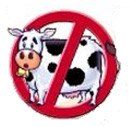
In her lifetime, an American dairy cow experiences many lifestyle changes.
1st Phase - Birth
From the moment of her artificially induced conception to her birth nine months later, she exists in the nurturing environment of her mother's womb.
2nd Phase - Productive life
After birth, bonding with her mother lasts for no more than a few minutes to couple of days. Does a calf experience separation anxiety? We should know the answer to that question after hearing her tortured cry (I have seen this in my visit to a dairy farm).
After separation, she is force-fed between one and two gallons of colostrums by the human farmer. Without this first nutrient-rich bovine milk, she would succumb to illness and die in her first two months of life.
Does the mother accept that separation? Each year, tens of thousands of incidents are reported in which angry cows seek revenge upon dairy farmers. Each year, hundreds of dairy farmers are trampled, gored, attacked, and killed. Newspaper accounts blame such incidents on irrational unthinking beasts.
Cows live a lifetime of stress so long as they produce enough milk to be profitable to the dairy farmer. Once she becomes unproductive (around 5 years of age), or once she becomes too diseased to be cured, she is culled (removed) from the herd.
3rd Phase - Unproductive Life Journey
About thirty percent of America's dairy cows are culled from herds each year. To be culled is to be taken from the familiar surroundings of a farm and packed onto a truck with other non-productive or diseased creatures. The fear factor culled cows experience is extreme.
Most Americans would guess that at this point the cow is sent to slaughter house. That is not so. Additional indignities await her. The true torture begins once the cow leaves the dairy farm. Her first stop is not the slaughterhouse but the auction ring.
Also once a cow leaves a farm for her ultimate death, compassion is no longer a concern to human handlers called middleman. Cows are loaded onto trucks at the dairy farm. The ride to auction can be traumatic. Terrified creatures are unloaded from the truck after bumpy rides in which they receive no food or water and are guided into holding pens. Employees of auction houses are often low paid workers who have no interest in animal rights issues. Their job is to move the animals in the proper direction. The cows are led into rings while spectators sit in tiered bleachers and offer bids to an auctioneer's call. (I have seen the auctioning of cows).
Many bidders sit in the audience, content to purchase number of animals depending upon the size of their slaughter operation. Each cow or calf awaits its turn… Twenty three cents per pound? Sold. Next.
4th Phase - Final Extinction
The cow is now owned by the successful bidder. It is his job to get the animal loaded onto his truck and shipped safely to his slaughterhouse facility. After experiencing a first truck ride, no cow wants to ever again climb the ramp onto man's vehicles. These are the most painful and undignified moments of a cow's life. Tails are grabbed and twisted. Nose rings are pulled and sometimes ripped from faces. Gentle creatures are stunned with high voltage electrical prods. Even the most stubborn of creatures eventually goes for her second and final ride.
All cows are slaughtered in America when they are around 5 years of age while their life expectancy is around 15 years. Some are to be slaughtered in factories, while others are to be slaughtered in sheds. Some receive a bullet to the head while others are stunned. (I have visited the American slaughter house).
5th Phase - Recycled Phase
The first step in the slaughter house is to cut their throats so that they are bled. One can see that some cows are awake and conscious during the bleeding process. Spurting blood is collected in 55-gallon drums during slaughtering process. Blood is then dried and processed into powder, then packed into 50 pound bags. Dairy farmers buy this commodity as a protein supplement to be fed to future cows and their offspring. American cows are no longer vegetarian cows. Their own blood protein is mixed with grains to feed the next generation of cows.
Conclusion
Twenty-seven million cows and other animals die each day in America.
If and when we drink a glass of milk, eat ice-cream, cheese, sweet, or for meat eaters, the meal of burger, or the nuggets, or the Colonel's crispy wings, we are eating the suffering and death of once living creatures.
During the 3rd phase of their journey, the middlemen who are responsible for transportation of the cows are the most abusive of human handlers (worst in India because of long journey), but they exist to serve the whims of the consumer. We eat the fruit of his abusive labor and we are complicit in their crime.
Jain Practice
For Jains, Ahimsa is our supreme principle, and yet we use dairy products such as milk, Ghee and sweet not only in our home but also in our temple rituals and Swāmivātslya dinner.
A cow is a five-sensed (Panchendriya) animal that also possesses mind. Cruelty to five-sensed animals is considered the highest sin and a person is destined to suffer in the hell as per our scriptures. In this situation a person will acquire following sinful karma
Narak Āyushya Karma
“Panchendriya Vadha, Mahā-ārambha, Mahā-parigraha, and Raudra parināmathi Narak Āyushya Bandhāya chhe”. - Jain Darshan by Muni Shri Nyāya VijayjiAdattādāna Karma
We are responsible for stealing the cows’ milk without her permissionAntarāya Karma
We are responsible for forcefully separating the mother and child.More than 6 million Americans are Vegan (New York Times Report), who do not use any animal products including dairy products such as milk, cheese, ice-cream, butter etc. About 10 to 15% Jain Youth are Vegan who attend YJA and YJP conventions. No Jain youth in America has denied the cruelty that exists in the American dairy industry or in fact in the dairy industries of the rest of the world. However there is a significant resistance among Jain adult populations in America, India and rest of the countries.
We earnestly request to the Jain community at large to study the subject from cruelty point of view. Significant literature is available on Internet and in book stores worldwide.
Hats off to Gurudev Shri Chitrabhanuji and Pramodaben.
My great reverence to Gurudev Shri Chitrabhanuji and Pramodaben for their total dedication to practice Vegan life style and spread the message of true Jain non-violence not only in America but throughout the world. I hope that the other Jain scholars study this subject rationally from the cruelty of Panchendriya animal point of view.
The treatment to the majority of cows in India is worst in many areas of their life cycle. Only less than 1.0% of cows get sheltered in animal shelter places called Pānjarā-poles. Hence more animal shelters will not solve the problem. The only rational solution to the problem is to eliminate the root cause of the problem. Eliminate the dairy products from our diet and rituals. Once the demand is reduced, the supply will be reduced and in-turn less cows will be produced and hence less cruelty in the world. That will greatly help our environment also.
Please introspect seriously our religious practices under the current environment. Do not follow the scriptures blindly otherwise our supreme ideal of nonviolence will not have any meaningful value attach to it. America is a land where we can practice our religion rationally. Our children will practice our religion rationally but we will miss the opportunity if we do not wake-up.
Please let me know if you find any error in the information described in this article.
If I have hurt any one’s feeling with this article, I sincerely request forgiveness.
Pravin K. Shah,
Chairperson of Jaina Education Committee
Federation of Jaina Associations in North America
919-859-4994
 Pravin K. Shah
Pravin K. Shah